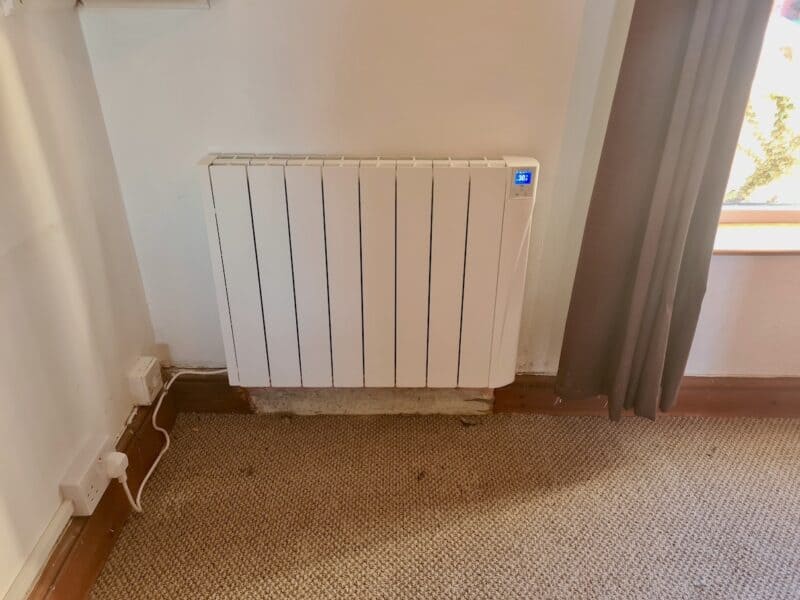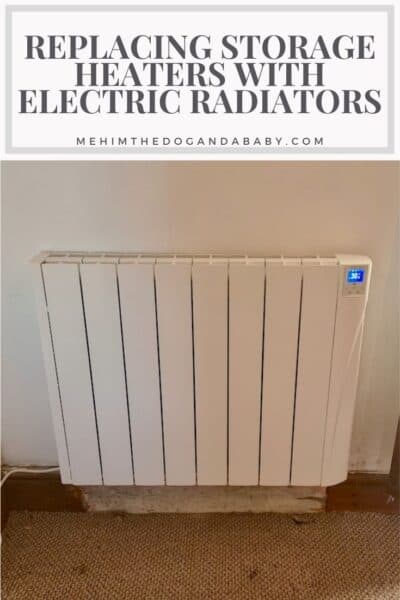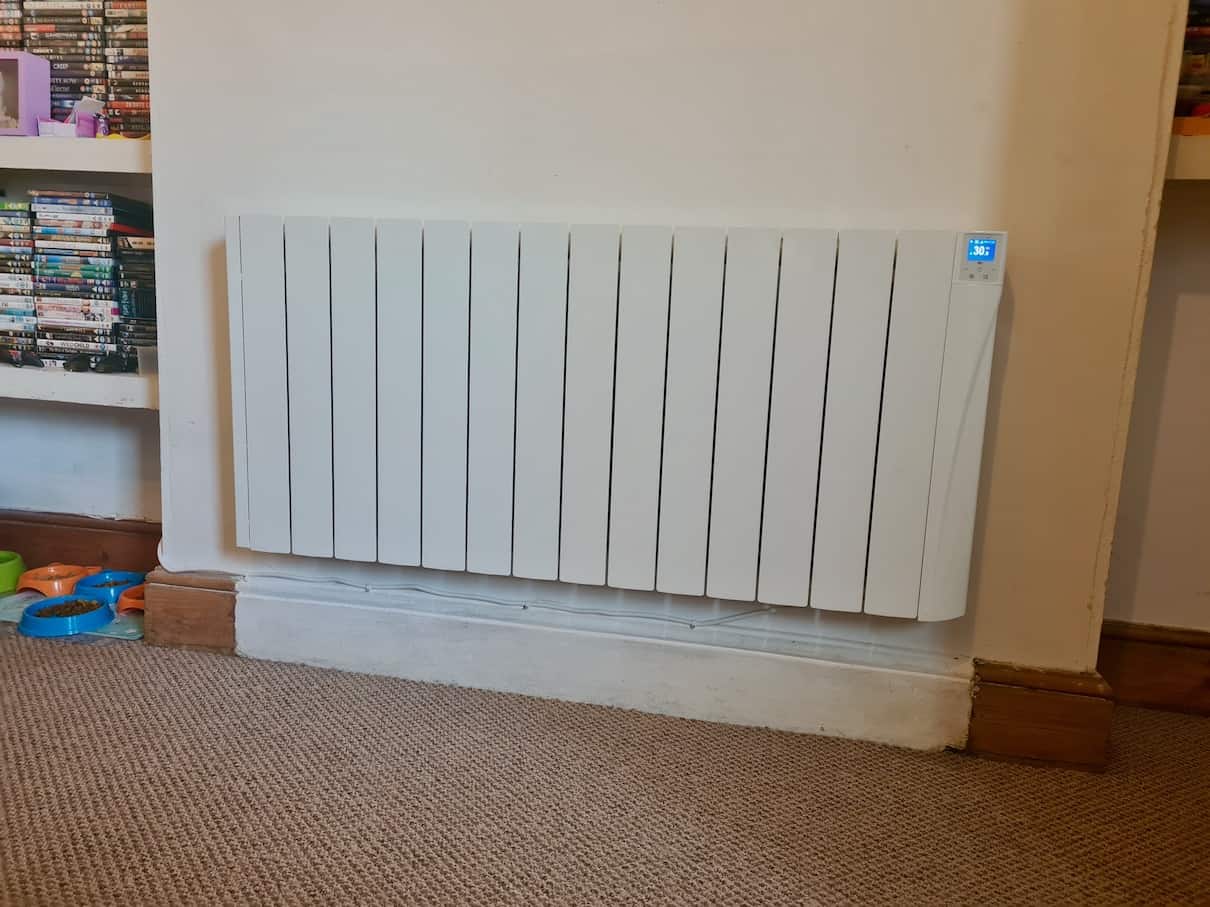When we moved into this house in 2014 we knew that there was quite a lot about it that we wanted to change. Actually, thinking about it, we probably wanted to change most of the house in some way or another. It definitely wasn’t ‘our’ house when we bought it.
One of the worst things about the house though was the water and heating system. The boiler is one of those old massive tanks that need to heat up before you can use the hot water and the heating was all night storage heaters, something we had experience of in the flat we lived in before. I’ll be honest, we probably should have thought more about this when we decided to buy the house but it’s easy to look back and think of things now.
The boiler and the storage heaters have always cost us quite a lot in electricity. Our house doesn’t use gas at all so everything is run on electricity. Storage heaters generally have to be on all of the time when you want to use them but we do have Economy 7 so they were cheaper to run over night. We found the storage heaters to be a real pain as we couldn’t control the heat as well as we wanted to.

Earlier this year we switched our energy supplier from Scottish Power to Bulb after having loads of problems. Our monthly payment is quite a bit lower during winter as it’s now spread out more equally over the whole year and this works out better for us. However, it wasn’t until we went to use the storage heaters that we realised something was wrong… none of them would work. It took us a while to figure out, and with the help of an electrician, but it seems that our Economy 7 meter no longer works.
With a 4 year old in the house being without heat wasn’t an option so we had to figure something out. Both Bulb and UK Power Network haven’t been much help yet so we decided to change the heaters. This was a pretty big decision as no matter what we chose it was going to be expensive. Going to a gas boiler and gas central heating wasn’t really an option because the cost and work is huge and not something we were in a position to do.
Our only real option was to change the storage heaters for electric radiators. We knew that they would not be the most efficient or cost effective way to heat the house but it was the easiest option and something we knew we could get sorted quickly. Probably a realistic-looking rising flames fireplace could have been an option, but not much to save there too, and moreover, my interiors would need a remake adding onto costs further. We also decided only to get the heaters sorted in the living room for now as it’s the room we use the most. There are so many options for electric radiators and it took a bit of research before I decided what I wanted.

Some electric radiators are only £50 or £60 but being used so often I wanted to spend more money on them. I wanted to buy something with a good warranty and with good reviews. I finally decided on two Harmoni Lugo+ electric radiators. Due to the size of our living room/ dining room and the location in which the radiators had to be we got one large and one smaller radiator costing about £740. It was a bit scary spending so much money on something we hadn’t seen in person though and we really just had to hope for the best.

Our electrician was great though and really made sure we had the radiators where we wanted them and added new sockets to make this happen. He also took away our old storage heaters in this room as well. Along with what we had to pay him we spent nearly £1000 on getting just 2 of the storage heaters replaced and it was a lot more than I was expecting.

We are so happy with the electric radiators though. They are easy to control, we can change the temperature easily and they really kick out some heat. Our 25ft room gets very warm and we only end up having the heaters on for a couple of hours. They might be expensive to run but we have them switched off most of the time so I don’t mind too much.
Now that we know we like the electric radiators we will slowly have the other 3 storage heaters removed (our bedroom, Erin’s bedroom and my office) and have them replaced. Now that we have the big room done we can do a room for about £400 and this will include the radiator itself and the electrician’s fee. We hardly ever need heating in these rooms though so they won’t be very high up on the list of things that need doing.
Update – find out how much the electric radiators have cost us to run over the past few months here.
PIN IT FOR LATER



Hi – this was exactly what I was looking for!
Out of curiosity, you mention the expense to run but don’t give any details in particular in regards to cost?
With them being installed in December and coming to the close of winter, what kind of running costs are you looking at per month?
Many thanks,
Steve
I’ll be writing an update soon with details of monthly bills etc. We had them installed in November, not December so wanted a few months to see what the bills were like.
hi there, thank you for posting this! I am about to the exact same, but wanted to know did you have the change the actual meter in your house, or do you still have the old metre and just changed the tariff? I cannot seem to find many details on this aspect of getting rid of storage heaters!
No, we didn’t change anything. The new radiators are plugged into regular sockets so they don’t use the economy 7 meter at all. Our economy 7 meter has just stayed where it is as other appliances in the house use it.
Unfortunately there are many misconceptions about storage heaters, one of which is that they are outmoded and should be replaced with modern panel heaters using normal day rate electricity. This is often a mistake as storage heaters although indisputably are more expensive than say, gas central heating, are still the most cost effective means of heating ones home if no gas is available simply because they use less than half price electricity which is provided via economy 7 rate. However, this depends a great deal on the type of household. If all occupants are at work during the day, panel heaters which use daytime electricity rates may well work out cheaper as the need for heating throughout the day is much reduced, but if your household is occupied during the day, every day, then panel heaters on for 14 to 16 hours will soon rack up your electricity bill. This is where storage heaters come into their own. If you’re at home all day the rooms need to be kept warm all the time and storage heaters will do this at much less cost than panel heaters.
As a retired electrician of many years I have had much experience in the fitting and servicing of storage heaters, there is little to go wrong with them, unlike gas boilers, they need next to no servicing and will run for decades with no problems.
One of the major problems I find is that consumers are often not able to get any information on how to get the best out of them and even manufacturing instructions when available tend to be confusing.
There are 2 simple controls on all storage heaters, one is for Input, to control the amount of heat stored, and the other is for Output, which controls the amount of heat released during the day.
The Output control when turned operates a very simple flap which allows more or less heat to be released depending on the setting of the control. I find often that user instructions state to turn this control to anywhere between 3 and 6 in order to release more heat. My suggestion is not to do this at least not until well into the evening. Why? Because you run the risk of the heater giving out all of its heat too early. My advice is always leave the output control on it’s lowest setting (,usually 1). Your heater then acts more like a radiator in a gas fired central heating system maintaining it’s heat well into the evening. The other problem with opening this flap controlled by the Output control by turning it to any other setting than 1 is people often forget to turn it back to 1 before they go to bed, as a result the room is too hot in the morning as much of the heat has already escaped.
As for the Input control most modern storage heaters can sense outside temperatures (,up to a point) so you can generally leave this on Max Setting as it will take only enough heat in overnight as required for the next day. Older storage heaters you may need to manually turn this control down to say 3 or 4 if weather forecast says it will be not be too cold the next day.
And yes you do need to keep an eye on temperatures as Spring and Autumn approaches adjusting input accordingly, but of course when Winter arrives proper there’s no need to do that as we need all the heat we can get so input on Max!
I hope this information may have been of some use to those of you with storage heaters and who may be considering changing to Panel Heaters.
I don’t have gas, am all electric and have had Storage heaters for over 35 years in my own home, yes they do cost more to run than gas central heating, but it’s swings and roundabouts, I have zilch maintenance costs, I have replaced 2 heaters over the years simply to replace older less efficient ones and am always warm and cozy, but then I’m retired so I’m home all the time so storage heaters work for me. I’m not against panel heaters, they have their place. But it all depends on your household’s situation.
Phil
thanks very much Phil. I have just moved into a second floor flat with 1980s storage heaters. I have been considering whether to replace with modern panel heaters but like you am retired so often at home all day. I shall replace with modern storage now I have read your very useful comments.
Thanks Jan